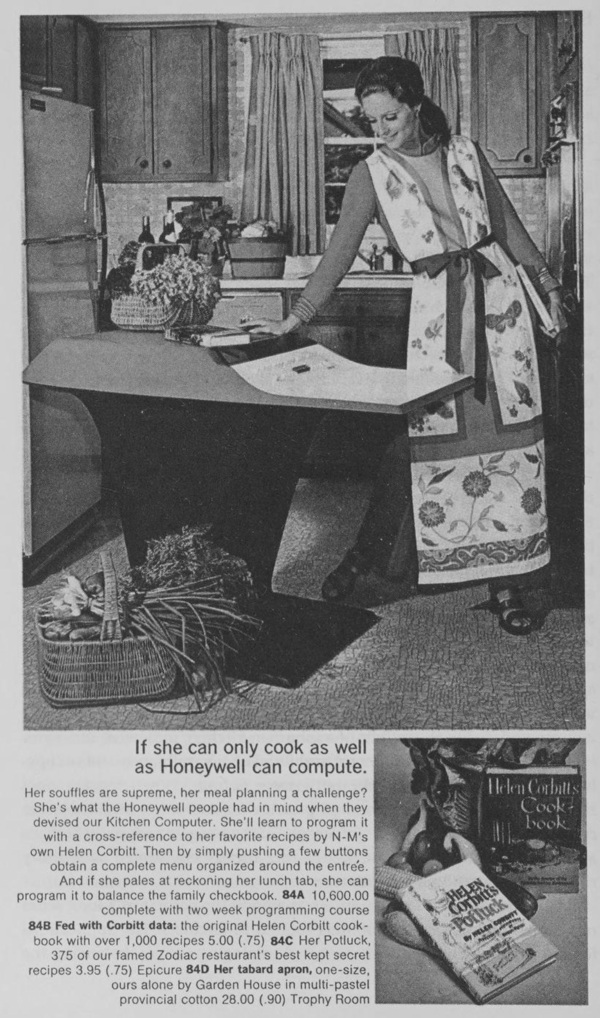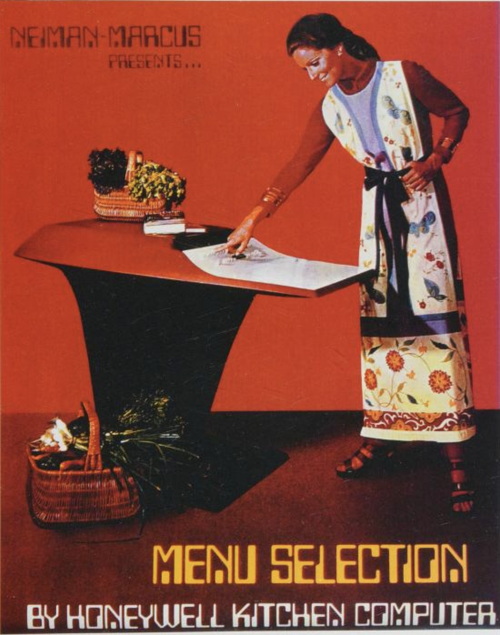The Honeywell Kitchen Computer
In 1969, Neiman Marcus offered a Honeywell "kitchen computer" in its Christmas catalog. The price tag was $10,600, which is equivalent to about $80,000 today. The price included a two-week course in programming, which was required to know how to use the computer. The computer could supposedly store recipes and help housewives plan meals.
No one ever bought one. Or rather, no one ever bought the "kitchen computer," but a few people (engineers, and the like) did buy the H316 minicomputer, which is what the kitchen computer really was. Neiman Marcus and Honeywell had simply repackaged the H316 as a kitchen computer.
Nevertheless, the "kitchen computer" is now credited as being the very first time a company had offered a home computer for sale. One of them is on display at the Computer History Museum.
More info: wikipedia

If someone had bought one of the kitchen computers, it would have been pretty much unusable, because a user had to communicate with it in binary code, using a series of 16 buttons on the front to enter data. From Wired:

No one ever bought one. Or rather, no one ever bought the "kitchen computer," but a few people (engineers, and the like) did buy the H316 minicomputer, which is what the kitchen computer really was. Neiman Marcus and Honeywell had simply repackaged the H316 as a kitchen computer.
Nevertheless, the "kitchen computer" is now credited as being the very first time a company had offered a home computer for sale. One of them is on display at the Computer History Museum.
More info: wikipedia

image source: Divining a Digital Future, by Paul Dourish and Genevieve Bell
If someone had bought one of the kitchen computers, it would have been pretty much unusable, because a user had to communicate with it in binary code, using a series of 16 buttons on the front to enter data. From Wired:
The thought that an average person, like a housewife, could have used it to streamline chores like cooking or bookkeeping was ridiculous, even if she aced the two-week programming course included in the $10,600 price tag. If the lady of the house wanted to build her family’s dinner around broccoli, she’d have to code in the green veggie as 0001101000. The kitchen computer would then suggest foods to pair with broccoli from its database by "speaking" its recommendations as a series of flashing lights.

image source: The Computer, by Mark Frauenfelder
Comments
I think that the Nieman Marcus Christmas Gift extravaganza items are more for publicity for the store than a realistic gift item, when you look at what they have offered through the years. I would be interested in seeing a run-down of all the items, and a tally of how many of each actually sold.
That being said, the Nieman Marcus catalog was interesting in a "let's see how the rich folk live" sort of way.
That being said, the Nieman Marcus catalog was interesting in a "let's see how the rich folk live" sort of way.
Posted by Patrick on 11/22/23 at 08:30 AM
A year or so later, we high school students used punch cards to write Fortran programs to be run on an IBM computer, and we got printed results. Our school didn't have a computer, so we had to go to the technical high school. So if Honeywell's input/output was switches and lights, they were way behind in terms of usability.
Posted by ges on 11/22/23 at 09:01 AM
I see this as a gimmick. From 1971 to 1975 I operated a CDC 1604 in the Navy on Oahu ( FOCCPAC (Kunia, the tunnel)) Even then it was outdated so they added a Honeywell 6000 (?) which was just a rebranded GE. All output was on tape or extra wide computer printouts. Way too clumsy for the home.
Posted by F.U.D. in Stockholm on 11/22/23 at 09:46 AM
The article suggested the user interface was the switch and light panel. This is not true.
Like most minicomputers of the era, the H316 had a communications link to an ASR-33 teletype. The ASR-33 looked like a typewriter, and printed on a continuous roll of paper. The H316 and the PDP-11 and the PDP-8 were all in related segments of the market. All had some kind of user interface that allowed character and word based commands. The H316 and the PDP-11 both had FORTRAN compilers.
One *could* load programs from the front panel switches and lights. This was often done to get the initial boot program in that would then be able to read user programs or something like an operating system in from paper tape.
The H316 had core memory, which persisted after power was turned off. Machines with core often held their boot program for months, allowing initial boot to be accomplished with the push of one switch.
So it isn’t all that outlandish that normal humans could have used the H316. In fact, it was not long before minicomputers like the H316 and the PDP-11 series started showing up in hotels and travel agencies.
Minicomputers like the Honeywell widget and the DEC PDP-11 became useful and easy to use lab instruments in thousands of labs and university centers.
But $10,000 to store recipes and balance the checkbook is a little steep.
Like most minicomputers of the era, the H316 had a communications link to an ASR-33 teletype. The ASR-33 looked like a typewriter, and printed on a continuous roll of paper. The H316 and the PDP-11 and the PDP-8 were all in related segments of the market. All had some kind of user interface that allowed character and word based commands. The H316 and the PDP-11 both had FORTRAN compilers.
One *could* load programs from the front panel switches and lights. This was often done to get the initial boot program in that would then be able to read user programs or something like an operating system in from paper tape.
The H316 had core memory, which persisted after power was turned off. Machines with core often held their boot program for months, allowing initial boot to be accomplished with the push of one switch.
So it isn’t all that outlandish that normal humans could have used the H316. In fact, it was not long before minicomputers like the H316 and the PDP-11 series started showing up in hotels and travel agencies.
Minicomputers like the Honeywell widget and the DEC PDP-11 became useful and easy to use lab instruments in thousands of labs and university centers.
But $10,000 to store recipes and balance the checkbook is a little steep.
Posted by RGeek on 11/22/23 at 06:54 PM
It sort of makes sense they'd do a stripped down version for home use. That was about the time I began writing programs for an IBM 360. We'd send them to the university where they were put on punch cards, run, and we'd get a printout back. The thing was, the card punch, card reader, and line printer took up just as much, if not more, space than the computer itself, and I wouldn't want those peripherals exposed to the smoke, fumes, and spatter of a normal kitchen. If someone had actually bought one of these, they'd probably have been told about other i/o options ay additional cost.
Jump forward a decade -- in 1981, my Toshiba T100 came with a 64 character x 8 line LCD display. Much better than reading the output byte by byte, but it still lacked a little something when running a word processing program.
Jump forward a decade -- in 1981, my Toshiba T100 came with a 64 character x 8 line LCD display. Much better than reading the output byte by byte, but it still lacked a little something when running a word processing program.
Posted by Phideaux on 11/23/23 at 01:27 AM
Commenting is not available in this channel entry.

Category: Technology | Computers | 1960s